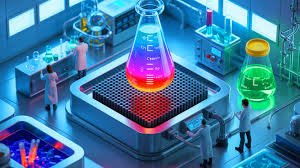Synthetic Fuels: Powering the Future with Cleaner Energy Alternatives
Introduction
As the world faces mounting pressure to reduce greenhouse gas emissions and transition away from fossil fuels, scientists and engineers are exploring innovative energy alternatives. One of the most promising developments in this area is synthetic fuels, often referred to as e-fuels or carbon-neutral fuels.
Synthetic fuels have the potential to revolutionize transportation, aviation, and heavy industry by offering a cleaner, sustainable substitute for gasoline, diesel, and jet fuel — without requiring a complete overhaul of existing engines or infrastructure.
But what exactly are synthetic fuels, how are they produced, and can they truly deliver a carbon-neutral future?

1. What Are Synthetic Fuels?
Synthetic fuels are man-made hydrocarbons produced from non-petroleum sources. Instead of being refined from crude oil, they are created through chemical processes that combine hydrogen (H₂) with carbon (C) extracted from carbon dioxide (CO₂) or carbon monoxide (CO).
The result is a liquid fuel that is chemically similar to conventional fossil fuels — meaning it can be used in current combustion engines, pipelines, and fueling infrastructure without major modifications.
Synthetic fuels can take various forms:
- Synthetic gasoline – used in cars and small engines.
- Synthetic diesel – used in trucks, ships, and generators.
- Synthetic jet fuel (e-kerosene) – used in aircraft.
- Synthetic natural gas (SNG) – used for heating and power generation.
Because synthetic fuels can be produced using renewable energy (like wind or solar power), they are often described as carbon-neutral fuels.
2. The Science Behind Synthetic Fuels
The production of synthetic fuels typically involves three key steps:
Step 1: Hydrogen Production
Hydrogen is extracted through a process called electrolysis, which uses electricity to split water (H₂O) into hydrogen (H₂) and oxygen (O₂).
When this electricity comes from renewable sources (solar, wind, or hydro), the hydrogen is referred to as green hydrogen.
Step 2: Carbon Capture
Carbon dioxide (CO₂) is captured either from industrial emissions (like factories or power plants) or directly from the atmosphere using Direct Air Capture (DAC) technology.
Step 3: Fuel Synthesis
The captured carbon and hydrogen are combined through chemical reactions such as the Fischer-Tropsch process or methanol synthesis to create liquid hydrocarbons. These synthetic fuels can then be refined to meet existing fuel standards.
Simplified Chemical Equation:
CO₂ + H₂ → Hydrocarbon fuel + H₂O
The result is a carbon-recycled fuel — when burned, it releases CO₂ back into the atmosphere, but ideally the same amount that was captured during its production. This makes the entire cycle carbon-neutral.

3. Types of Synthetic Fuels
- Power-to-Liquid (PtL): Converts electricity into liquid fuels like gasoline, diesel, or jet fuel.
- Power-to-Gas (PtG): Produces synthetic methane or hydrogen gas.
- Biomass-to-Liquid (BtL): Uses biomass (wood, waste, or algae) as a carbon source instead of CO₂.
- E-Methanol: A clean, versatile liquid fuel that can also be used as a chemical feedstock.
- E-Kerosene: Specifically designed as a sustainable alternative to aviation fuel.
4. Advantages of Synthetic Fuels
a. Carbon Neutrality
When produced using renewable energy and captured CO₂, synthetic fuels can achieve near-zero net emissions. The CO₂ released during combustion equals the amount previously removed from the air.
b. Compatibility with Existing Infrastructure
Unlike hydrogen or electric vehicles, synthetic fuels work seamlessly with:
- Existing internal combustion engines
- Current fuel stations
- Established storage and distribution networks
This makes them a practical solution for hard-to-electrify sectors like aviation, shipping, and heavy trucking.
c. Energy Storage and Transport
d. Global Energy Security
Countries can produce synthetic fuels domestically using renewable resources, reducing dependence on imported crude oil.

5. Challenges and Limitations
Despite their potential, synthetic fuels face several hurdles:
a. High Production Costs
Current production methods are energy-intensive and expensive, making synthetic fuels costlier than fossil fuels. The electrolysis and carbon capture processes require significant amounts of renewable electricity.
b. Energy Efficiency
The overall energy efficiency of synthetic fuel production is lower compared to direct electrification. Some studies show that up to 70% of the input energy can be lost in conversion processes.
c. Limited Availability of Renewable Power
To scale production, vast amounts of renewable electricity are needed. Until green energy is abundant and cheap, widespread adoption of synthetic fuels will remain challenging.
d. Infrastructure and Investment
While existing infrastructure can handle synthetic fuels, building production plants and carbon-capture facilities requires massive upfront investment.
6. The Role of Synthetic Fuels in the Transport Sector
a. Automotive Industry
Although electric vehicles (EVs) are becoming dominant, synthetic fuels offer an alternative for:
- Existing petrol and diesel cars (without modification)
- Regions with limited EV infrastructure
- Classic or high-performance vehicles where engine preservation is key
b. Aviation
The aviation sector is one of the biggest targets for e-fuel development.
E-kerosene, a synthetic alternative to jet fuel, can drastically cut aviation emissions while being fully compatible with existing jet engines and airports.
c. Shipping and Marine Transport
Large cargo ships and tankers require immense energy. Synthetic diesel or methanol can offer a cleaner alternative to bunker fuel without major retrofitting.
d. Industry and Power Generation
Synthetic natural gas and liquid fuels can be used in industries that require high-temperature heat or as backup energy sources for renewable power systems.
7. Global Efforts and Projects
Several nations and corporations are investing in synthetic fuel technology:
- Germany has led many pilot projects, such as the Haru Oni project in Chile (by Siemens Energy and Porsche), producing synthetic fuel using wind energy.
- Japan and South Korea are exploring synthetic fuels for their automotive and shipping sectors.
- Airbus and Rolls-Royce are testing aircraft engines that can run entirely on e-fuels.
- Saudi Arabia and Australia are investigating large-scale hydrogen and e-fuel export systems powered by solar energy.
The European Union has also introduced policies supporting e-fuels as part of its “Fit for 55” climate package, allowing their use in achieving carbon neutrality by 2050.
8. The Future of Synthetic Fuels
The next decade will be crucial for the growth of synthetic fuels. Costs are expected to drop as technology improves and renewable power becomes cheaper. With proper policy support, synthetic fuels could become a major player in achieving net-zero emissions by mid-century.
Future advancements likely to accelerate progress include:
- Cheaper electrolysis technology (solid oxide and PEM systems)
- More efficient carbon capture systems
- Integrated renewable energy hubs producing e-fuels on-site
Analysts predict that by 2040, synthetic fuels could supply a significant share of global transport energy, particularly in aviation and shipping.

9. Comparison: Synthetic Fuels vs. Other Alternatives
| Aspect | Synthetic Fuels | Electric Vehicles (EVs) | Hydrogen Fuel Cells |
|---|---|---|---|
| Infrastructure | Uses existing systems | Requires charging networks | Requires hydrogen stations |
| Emissions | Carbon-neutral (if green) | Zero tailpipe | Zero tailpipe |
| Energy Efficiency | Moderate | Very high | High |
| Cost (current) | High | Moderate | High |
| Best Use | Aviation, shipping, existing cars | Passenger cars | Trucks, buses, industry |
Each technology has its place in the global transition to clean energy. Rather than competing, they complement one another in achieving sustainability across different sectors.

10. Conclusion
Synthetic fuels represent one of the most innovative and realistic pathways toward a carbon-neutral future. By recycling CO₂ and harnessing renewable energy, they offer a powerful solution for reducing emissions while preserving today’s transportation systems and infrastructure.
Though challenges remain—particularly around cost and efficiency—the potential environmental and economic benefits are immense. As technology advances and renewable energy expands, synthetic fuels could play a critical role in closing the gap between current fossil dependence and a fully sustainable energy ecosystem.
In the race to decarbonize our planet, synthetic fuels may not be the only answer — but they are an essential part of the solution.








Post Comment